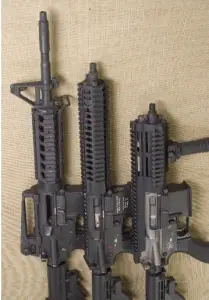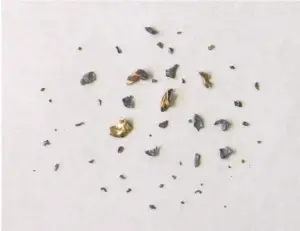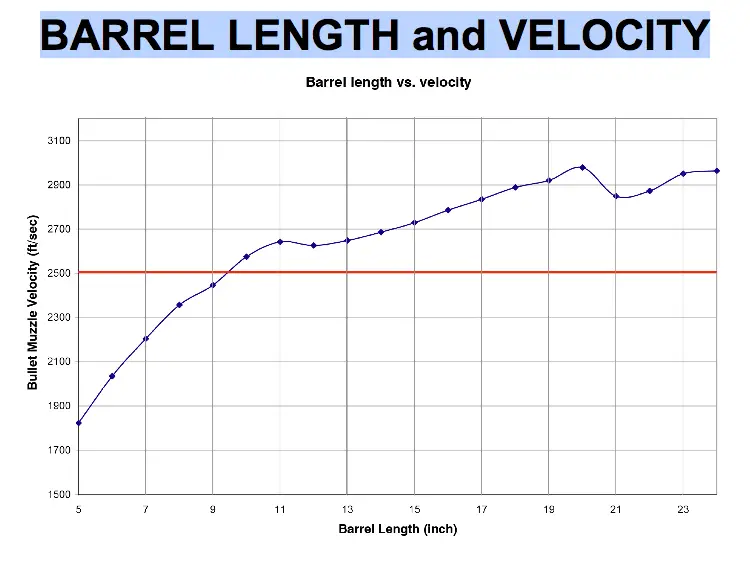 We’ve already met the Swedish firm CBJ Tech, with their interesting 6.5 x 25mm saboted cartridge, whose subcaliber (4mm) penetrator gives the pistol-sized round exterior ballistic performnce closely mirroring the standard American 14.5″ Colt carbine.
We’ve already met the Swedish firm CBJ Tech, with their interesting 6.5 x 25mm saboted cartridge, whose subcaliber (4mm) penetrator gives the pistol-sized round exterior ballistic performnce closely mirroring the standard American 14.5″ Colt carbine.
Noe here’s a report from the company that criticises the performance of the 5.56mm round from short barrels. Let’s cut to the conclusion of that report:
This report has shown the problems with terminal effectiveness associated with short-barreled 5.56×45 NATO assault rifles. The bullet travels too far before yawing, producing only minimal tissue disruption with a resulting low chance of rapid incapacitation of the target. Considering the generally short combat ranges when this weapon type is used, this is a serious deficiency. An important note is that the bullet in question is in no way “weak”; it certainly has the energy to produce a massive wound, which it very well may if it is caused to tumble earlier. This can be the case when the bullet passes intermediate obstacles, gear, bone etc. Still, the tendency of the 5.56×45 NATO cartridge to fail in terminal effect at lower velocities is important, when considering replacing standard length assault rifles with more compact weapons.
Now, before we flip our lid over this, let’s take a look at the limitations of CNJ’s study. There are some glaring anomalies in their experimental design and methodology.
- They appear to compare only one shot from each barrel length. That’s statistically insupportable, if you want to draw any kind of practical inferences. The Law of Large Numbers doesn’t take effect from “2.”
- They only use two barrel lengths.
- The delta between the two barrel lengths (over 9 inches) is greater than the usual delta between a rifle and a shorter carbine or CQB variant. For example, the M16A2’s shorter substitute is the M4 or M4A1 with a 14.5″ barrel- difference of 5.5″. To get a difference of 9 inches you have to go all the way from the full-length M16A2 platform down to the SOF-unique 10.5″ CQB upper.
- They use dissimilar weapons with dissimilar chambers and rifling. In fact, one of the weapons they use is an H&K, and that company made a lot of noise during the period that weapon was made about the ballistic superiority of their polygonal rifling. That claim remains extremely controversial thirty years later.
- The weapons that they use are of unknown
- They use a round that’s designed for long-range penetration (the Swedish SK5 is fundamentally a clone of the Nato M855 round, which was designed with no terminal-ballistic goal except to penetrate a Russian helmet at 800m).
- They use ballistic gelatin, which is a very imperfect model of mammalian tissue.
- They rely on bullet fragmentation at higher velocity, which practical experience teaches us is a sometime thing.
- They have a strong interest in the outcome of the test, and are hardly a disinterested product lab. This raises the suspicion that the two shots that they did compare were not the only two shots, and were not two randomly selected shots, but were the two shots that produced the greatest disparity between the terminal effect of the short-barreled HK and the long-barreled FNC.
The CBJ Tech guys are arguing that the muzzle velocity (and hence energy, V=1/2MV2 ) diminishes so rapidly as to render the round nonlethal at close range (these tests were taken at 8 meters) in a short-barreled carbine. The velocities they record — they don’t say at what distance, so we’ll assume muzzle, the standard measurement point — are 926 m/s for the long barrel and 708 m/s for the shorty. That comes out to about 3028 fps for the long barrel (449mm, about 17 2/3″) and 2323 fps for the short barrel (210mm, about 8 1/4″). The difference is 715 fps over 9.4 inches or about 76 fps per inch less.
That seems to be an outlier for velocity loss from shortened barrels.
Here is a page by Chuck Hawks on rifle barrels, which reproduces several rules of thumb and specific claims about velocity, from fairly authoritative sources. The high-end claim comes from the 2001 Shooter’s Bible and still falls short of the CBJ observed result: 50 fps/inch. O’Connor in The Rifle Book claimed 25 fps. But CBJ’s result for this number is higher than the Bible and Book results — combined. The Lyman Reloading Manual and Remington Catalog both suggest that velocity loss in a shorter barrel is dependent, in part, on the velocity range of the cartridge, and they give the exact same numbers — a round in the 3,000 fps neighborhood should lose 20-30 fps for every inch the barrel’s shortened. That’s functionally the same claim as O’Connor’s (is your chronograph really accurate to 5 fps?).
At this point, we remind you that it is in CBJ’s interest to show a very high reduction in velocity and lethality in short-barreled carbines, because their saboted round takes a short barrel with much less velocity loss.
Now, the real gold standard on velocity loss data would be if someone made a long-barreled rifle and then measured the results as he lopped the inches off. Has anybody ever done that?
- Well, yeah. Clint Smith at Guns Magazine tried it with a .300 Win Mag, a 2,700 fps neighborhood cartridge. They fired for accuracy and chronograph, trimmed two inches and recrowned and reshot, and repeated to minimum legal length (16″from a start of 24″). They lost 350 fps over those 8 inches (~44 fps/inch, close to the Shooter’s Bible number but only about 60% of CBJ’s).
- David LaPell notes that Phil Sharpe tried it with a .30-06 and recorded only a 12 fps/inch loss. Sharpe started with a long barrel on a Springfield action and ended with a 12″ one, which must have been pretty odd-looking. Still, anything for science.
- An Army shooter’s granddaughter (!) did an experiment with a .308, starting with 26″ and ending with 16″ — losing 274 fps total.
- A very well documented undergraduate paper by Brandon Louis Clark of the University of South Florida collected data whilst a 7.62 x 54mm Mosin-Nagant rifle was shortened from its factory barrel length of 28.75″ to 16.75″. This 12-inch reduction, taken in increments of 2″, confirmed Sharpe’s 1950 conclusion that velocity was reduced linearly as a barrel was shortened from anything less than or equal to optimal length. The reduction was from 2827 fps to 2521 fps (306 fps, or about 25.7 fps/inch).
- Finally, we’ve discussed Phil Dater’s experiments before. Here’s an article in Small Arms Defense Journal about his experiments with a progressively shortened 5.56mm AR-15, which he took from 24″ down to 5″. (Interesting: he says that 10.5 or even 9 inches may be reasonable in a CQB gun, but 7 or 8 is too short., based on his determination that 2,500 fps is the threshold for sufficient terminal ballistic effect. The CBJ Tech “bad example”gun was about 8 1/4”). And here’s a presentation he gave at NDIA in 2010. One slide:
There are some interesting points on that chart. First, this is the least linear of any of the sources on length and velocity, and yet it’s still pretty linear. Next, note that the 5.56 had its peak muzzle velocity at the 20″ point. (Not too surprising — that’s the barrel length the M855 round was designed for). Finally, the red line shows the 2500-fps point that Dater considers the threshold for terminal-ballistic effect. The 8″ HK used by CBJ tech would fall to the left of the velocity line’s threshold crossing, while the 10.5″ CQB uppers now issued to SF are on the right side of it.
We’re not doubting that the CBJ Tech experimenters actually got their data, just pointing out that entirely apart from the methodological and experimental design problems, their velocity reduction numbers are out of line with the body of science that’s already out there. So why are the CBJ Tech data anomalous?
And what makes them think their saboted 4mm penetrator will not likewise be ineffective at CQB ranges (in this case by overspeed)? Of course, they know it will, which is why they also offer full-bore (nonsaboted) CQB loads for their 6.25 x 25mm round.

Kevin was a former Special Forces weapons man (MOS 18B, before the 18 series, 11B with Skill Qualification Indicator of S). His focus was on weapons: their history, effects and employment. He started WeaponsMan.com in 2011 and operated it until he passed away in 2017. His work is being preserved here at the request of his family.



3 thoughts on “Effects of a Short Barrel”
great article! I always wondered how much velocity I was loosing going from a 14.5 to an 11.5 – surprisingly not much according to this article. I can tell by the article you have some STATS under your belt as well. It’s refreshing to read a weapons article that isn’t… juvenile and nonobjective. But I wonder if you have any insight on diminishing accuracy effects of SBRs. I’d be interested to read that as well. For me it’s all about balancing performance with ergonomics. Getting in and out of trucks, clearing buildings and patrolling are made much easier with a weapon that’s more compact.
Byron, accuracy is much more a function of quality of a barrel than it is of length. Lots of things go into that “quality” including dimensions, surface finish (which has to be “just right” to let the pressure curve build), rifling profile, and — especially — muzzle crowning. I think the Phil Dater data include accuracy as well as velocity and pressure numbers, but I could be wrong about that as I have been nose down in other stuff. But about the only accuracy effect of a longer barrel is a longer sight radius — a moot point using modern sights.
I hear you on vehicular stuff. It was no fun being an old man in the back seat of a Hilux when it was time to dismount.
I should have added, if you can make a 10.5 or 11.5 work (it’s a matter of port size, mostly) you should be good to go. The data indicate that the real subgun barrels (8, 7.5 etc) give up enough velocity you may be in a bad place in terminal ballistics — but the existing data on terminal ballistics are lousy.